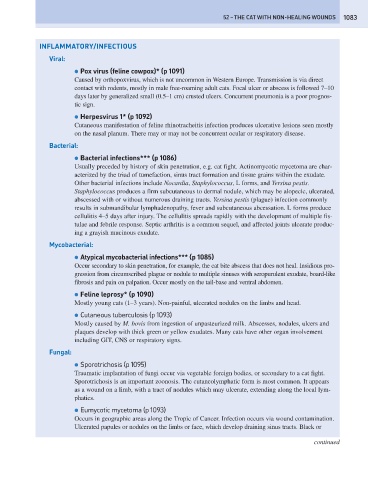Page 1091 - Problem-Based Feline Medicine
P. 1091
52 – THE CAT WITH NON-HEALING WOUNDS 1083
INFLAMMATORY/INFECTIOUS
Viral:
● Pox virus (feline cowpox)* (p 1091)
Caused by orthopoxvirus, which is not uncommon in Western Europe. Transmission is via direct
contact with rodents, mostly in male free-roaming adult cats. Focal ulcer or abscess is followed 7–10
days later by generalized small (0.5–1 cm) crusted ulcers. Concurrent pneumonia is a poor prognos-
tic sign.
● Herpesvirus 1* (p 1092)
Cutaneous manifestation of feline rhinotracheitis infection produces ulcerative lesions seen mostly
on the nasal planum. There may or may not be concurrent ocular or respiratory disease.
Bacterial:
● Bacterial infections*** (p 1086)
Usually preceded by history of skin penetration, e.g. cat fight. Actinomycotic mycetoma are char-
acterized by the triad of tumefaction, sinus tract formation and tissue grains within the exudate.
Other bacterial infections include Nocardia, Staphylococcus, L forms, and Yersina pestis.
Staphylococcus produces a firm subcutaneous to dermal nodule, which may be alopecic, ulcerated,
abscessed with or without numerous draining tracts. Yersina pestis (plague) infection commonly
results in submandibular lymphadenopathy, fever and subcutaneous abcessation. L forms produce
cellulitis 4–5 days after injury. The cellulitis spreads rapidly with the development of multiple fis-
tulae and febrile response. Septic arthritis is a common sequel, and affected joints ulcerate produc-
ing a grayish mucinous exudate.
Mycobacterial:
● Atypical mycobacterial infections*** (p 1085)
Occur secondary to skin penetration, for example, the cat bite abscess that does not heal. Insidious pro-
gression from circumscribed plague or nodule to multiple sinuses with seropurulent exudate, board-like
fibrosis and pain on palpation. Occur mostly on the tail-base and ventral abdomen.
● Feline leprosy* (p 1090)
Mostly young cats (1–3 years). Non-painful, ulcerated nodules on the limbs and head.
● Cutaneous tuberculosis (p 1093)
Mostly caused by M. bovis from ingestion of unpasteurized milk. Abscesses, nodules, ulcers and
plaques develop with thick green or yellow exudates. Many cats have other organ involvement
including GIT, CNS or respiratory signs.
Fungal:
● Sporotrichosis (p 1095)
Traumatic implantation of fungi occur via vegetable foreign bodies, or secondary to a cat fight.
Sporotrichosis is an important zoonosis. The cutaneolymphatic form is most common. It appears
as a wound on a limb, with a tract of nodules which may ulcerate, extending along the local lym-
phatics.
● Eumycotic mycetoma (p 1093)
Occurs in geographic areas along the Tropic of Cancer. Infection occurs via wound contamination.
Ulcerated papules or nodules on the limbs or face, which develop draining sinus tracts. Black or
continued

